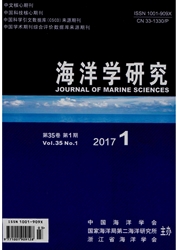

 中文摘要:
中文摘要:
利用2003年大洋DY105—12,14航次在中太平洋海山获取的KXD28富钴结壳样品,采用气相色谱(GC)内标法对该结壳样品的分层样进行了可溶有机质(氯仿沥青“A”)及其族组成(饱和烃、芳烃、非烃)、正构烷烃、类异戊二烯烃的定量分析,并结合总有机碳(TOC)及有机碳同位素(δ13C)分析,探讨了结壳样品有机质来源及富钴结壳组成与生长环境之间的关系。结果表明:(1)富钴结壳中有机质生物母源主要为海洋生物和菌藻类,并混有少量陆源物质;有机碳同位素同样也指示了海洋水生生物碳同位素特征;(2)KXD28结壳从底层到最外层有机碳同位素发生了很大变化,结壳中有机碳同位素组成变化与结壳生长过程中的海洋环境气候相符合:富钴结壳生长前期δ^13C组成由正变负,对应全球气候变冷,南极底层流向太平洋挺进;而富钴结壳生长后期δ^13C逐渐偏正,与全球气候变暖和南极底层流萎缩相关联。
 英文摘要:
英文摘要:
The cobalt-rich (Co-rich) crust sample KXD28 was obtained from Mid-Pacific seamounts during DY105-12,14 cruise. The contents of soluble organic matter (chloroform bitumen "A") and its group compositions (saturated hydrocarbon, aromatic hydrocarbons and resin), n-alkanes and isoprenoid hydrocarbon were analyzed quantitatively using gas chromatography (GC) internal standard method. Total organic carbon (TOC) and organic carbon isotope (δ13C) in the cobalt-rich crusts were also detected. Compared with the analyzed results from the sediments nearby metallogenic zone, and using the abundance data of organic matter composition recorded in the crust layer and in the seafloor sediments, the ecological environment of seamounts in the past, as well as the Co-rich crust forming environment and evolution characteristics were studied. Finally, the relationship between the composition of the crust and the environment of growth was investigated. And our principal conclusions show that= (1)The biomarkers of n- alkanes and isoprenoid hydrocarbons were detected in Co-rich crusts. According to the molecular characteristics index, main peak of carbon, ∑nC23-/∑nC24+, CPI, Pr/Ph, Pr/nC17 and Ph/nC18, it is indicated that crust sample KXD28 was originated mainly from the sinking or floating hydrophily macrophytes and homonemeaes with less terrigenous materials. The organic carbon isotopes also matched with the carbon isotope characteristics of marine aquatic organisms; (2) The changes of the organic carbon isotopes of crust were consistent with the changes of marine environment and climate during the crusts' growth. Before crusts formed, and in the early period of crusts' growth,δ13C changed from positive to negative, corresponding to global cooling and Antarctic Bottom Water flowing into Pacific. During the late period of crusts' growth,δ13C turned positive gradually, related to global warming and Antarctic Bottom Water receding.
 同期刊论文项目
同期刊论文项目
 同项目期刊论文
同项目期刊论文
 期刊信息
期刊信息
